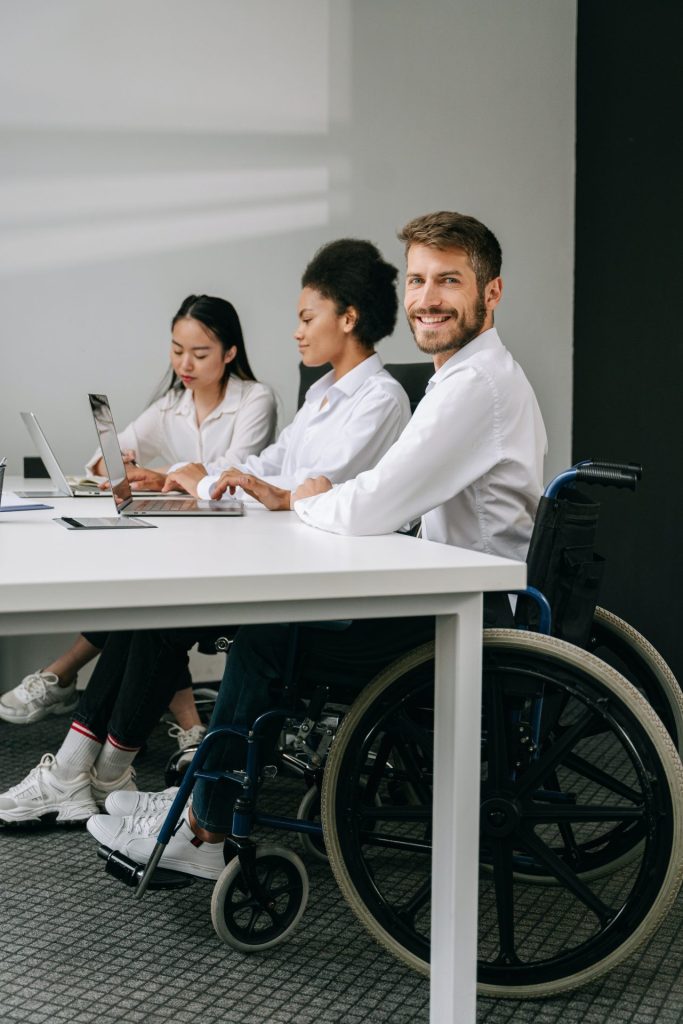Many businesses are starting to focus on diversity, equity, and inclusion (DEI) in the workplace. However, often the “diversity” conversation excludes people with disabilities. Some people believe that disability is often seen as an individual problem to solve, rather than a natural part of human diversity. This misconception can lead to exclusion and misunderstandings in organizations.
In this blog post, we explore the importance of recognizing and embracing disability as part of workplace diversity. We will also explain key terms and concepts to set the stage for further discussion.
Disability as diversity: Benefits
There are many advantages to including people with disabilities in corporate diversity, equity, and inclusion (DEI) strategies. An Accenture report called “Getting to Equal: The Disability Inclusion Advantage” found that companies that prioritize disability employment and inclusion tend to have higher revenue, net income, economic profit margins, and total shareholder returns compared to their peers. People with disabilities make up the largest and fastest-growing minority group globally, with over 750 million individuals in the talent pool. By including individuals with disabilities, organizations can access a broader talent pool, which is especially important during times of talent shortages like The Great Resignation.
People with disabilities often have multiple social identities, making disability inclusion an essential aspect of intersectionality. For example, individuals like Ola and Regina, who are Black women living with disabilities, bring unique perspectives to the table. Creating a disability-inclusive environment benefits both businesses and employees. Including people of all abilities can increase creativity, bring new ideas, and offer unique problem-solving approaches. This inclusivity can lead to a competitive edge for companies. Treating people with disabilities with kindness and compassion at work can boost employee engagement, commitment, workplace satisfaction, and retention. This positive work environment can also enhance customer satisfaction and attract new customers.
Learning the vocabulary around disabilities
Learning the vocabulary around disabilities is an important step toward creating an inclusive and respectful workplace. Here are some key terms and definitions:
Ableism
Ableism is when people discriminate against or show prejudice towards those with disabilities or those perceived to have disabilities. It’s about seeing them as inferior because of their disabilities and treating them unfairly. Here are some examples of ableism:
- Feeling pity for someone with a disability
- Thinking that people with disabilities are less capable than those without disabilities
- Making jokes or mocking people with disabilities
- Asking people with disabilities if they can be “fixed”
Accessibility/Accessible
Accessibility is very important to me and others like me who have disabilities. It can be really tough to get around when places are not accessible. As a blind person, accessibility is crucial for me to be independent. When I was younger, I had a hard time because many things, like websites and documents, were not accessible to me. I had to rely on others to read important papers to me because I couldn’t read them myself. But now, with the help of technology like screen readers, I can do more things on my own. However, there are still many challenges that people with disabilities face in today’s society.
Barrier
A barrier is like a roadblock that makes it hard for someone with a disability to live independently, work, travel, or access buildings and services. Barriers can be attitudes, communication, physical obstacles, rules, programs, societal norms, or transportation issues.
Challenges are a part of life for everyone, but some people face bigger obstacles than others. Discrimination is a huge barrier, like racism, sexism, or other unfair treatment. Discrimination can harm a person’s mental and physical health, education, job opportunities, and overall well-being. It can also lead to social isolation.
Disability
The definition of disability can vary by country, but in the United States, the Americans with Disabilities Act (ADA) protects individuals with physical or mental impairments that significantly limit their daily activities. In the UK, the Equality Act 2010 defines disability as a long-term impairment that affects normal daily activities.
Disabilities can fall into categories like chronic health conditions, sensory impairments, and mental health or learning disabilities. They can also be classified as visible or hidden. Visible disabilities are noticeable to others, while hidden disabilities are not immediately apparent and can include chronic illnesses like back pain or ADHD.
The distinction between visible and hidden disabilities is not always clear, as someone may choose to disclose their disability or it may become visible over time. People with disabilities may have multiple conditions, and these conditions can change over time.
Conclusion
In conclusion, embracing disability diversity in the workplace is crucial for creating an inclusive and supportive environment for all employees. By recognizing the unique skills and perspectives that individuals with disabilities bring to the table, organizations can foster a culture of innovation and equality. It is important for companies to implement policies and practices that prioritize accessibility and accommodation, in order to ensure that all employees have the opportunity to succeed. Ultimately, by valuing and respecting the contributions of individuals with disabilities, businesses can create a more diverse and inclusive workforce that benefits everyone.

